Let me throw this in the mix for more interesting information

'Rubescens' and Other Red Peacocks from Germany
By Keegan Armke (11-97)
As the newest peacock color variety finds its way from Germany to the U.S., it’s not surprising that A. sp. “Rubescens” is wrapped in some controversy.
In a recent issue of an American Cichlid Association publication, there is a view expressed that all of the “Red” peacock color morphs being developed in Germany are really the same fish being offered under different names.
I don’t agree with this thinking. I phoned and explained to the writer, who admittedly does not keep the fish, that our aquaria housed “German Red Peacocks”, “Rubescens Peacocks” and “Eureka Red Peacocks”—all of which share a German origin—and that these fish decidedly, emphatically are not the same peacocks in terms of looks.
To be brief:
Auloncara sp. “Rubescens” exhibits a bright orange coloration through the body and fins which contrasts with a small amount of blue on the head. Females have a distinct orange outline across the dorsal fin. In my experience, it is much more peaceful than the average peacock. From a color standpoint, it is my favorite peacock.
Auloncara sp. “German Red” differs from “Rubescens” in that it has many more blue striations in the head, body and fins—enough blue all over that the impression is of a red-orange and blue fish. We have kept groups of “German Reds” from several different sources, including one group which was direct from Germany.
Auloncara sp. “Eureka Red” has a longer body and more sloped head and, moreover, has an entirely different pattern of reds and blues than either of the previous two fish. It is also much more aggressive—no doubt because of its probable origin as a jackobfreibergi.
The “Rubescens” and “German Red”, according to knowledgeable worldwide sources, derive from another peacock species. The original sources say the “Rubescens” was developed from A. baenschi (Maleri Island) and the “German Red” from A. baenschi (Chipoka). Until someone convinces me differently, I’ll accept this information. The color patterns fit the original fish quite well.
It’s important to note in this discussion that the “Red” peacocks from Germany do not appear to be the products of hybridization. Instead, they are produced by line-breeding special morphs of a species—the same type of development which originally produced albino corydoras, fantail guppies, lyretail mollies, etc.
(Note: The “Rubescens” is sometimes called “Ruby Red Peacock” in an attempt to Americanize the German name.)


